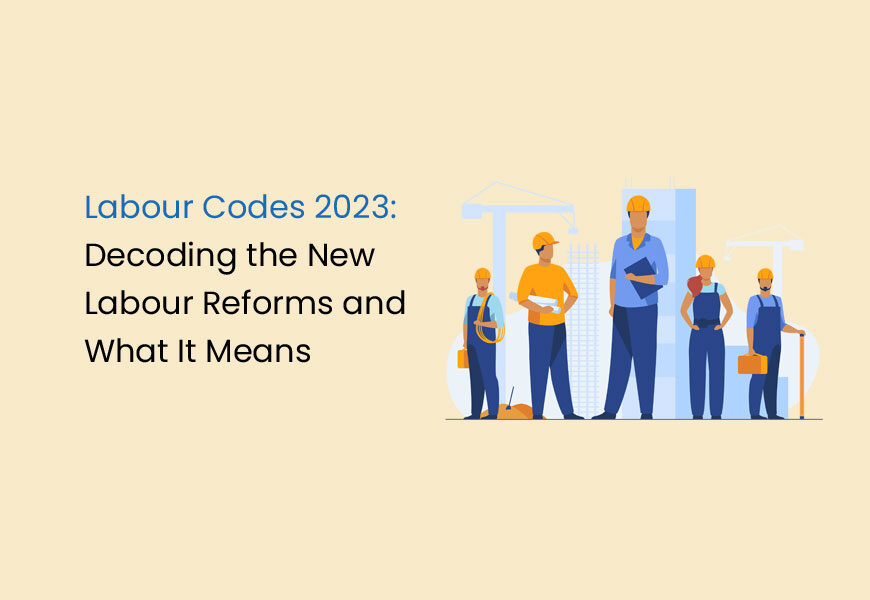For the first time after Indian independence in 1947, the central government revamped the Labour Laws to empower workers (formal and informal) from the organized and unorganized sectors. The twenty-nine labour laws are codified into four major Labour Codes to initiate reforms and provide better social security benefits and working conditions to employees.
Though many workers benefit from schemes like EPF and ESIC, several informal workers are still unable to access social security benefits. Apps like TankhaPay are bringing a revolutionary change by bridging the gap between informal workers and employee benefits.
The latest labour code aims to empower the 50+ crores of workers in the organized sector to improve their standard of living and lead better lives by accessing the schemes and benefits they deserve. Let’s read more about the four new labour codes in India.
What Prompted the Introduction and Passing of the Four New Labour Codes?
Statistics show that more than 90% of the workers in the country belong to the unorganized sector. This includes informal workers like house help, temporary and contract labourer, delivery personnel, caregivers, gardeners, etc.
The Second National Commission of Labour recommended the codification of labour laws in 2002. However, the issue was finally taken up recently, and the current central government first introduced the four labour codes in the parliament in 2020.
After 75 years of independence, over 50 crore workers from organized and unorganized sectors can avail of the various social security benefits under the Shramev Jayate Scheme.
From providing workers with a UAN (Universal Account Number) for the withdrawal of PF funds to the Pradhan Mantri Man Dhan Yojana, where workers aged 60 years (belonging to the unorganized sector) receive a pension of Rs. 3000/- per month, many new initiatives have been introduced to empower workers lead dignified lives.
The government aims to establish transparency and accountability by streamlining the systems and procedures using technology. The labour codes are broadly categorized into the following:
The Minimum Wages Code — Workers Earn What They Deserve
Four of the twenty-nine labour laws have been clubbed to form the Minimum Wages Code. It gives over crore workers the right to demand a minimum wage for the first time.
Key Highlights of Minimum Wages Code
- Guaranteed timely payment of wages to each worker
- The minimum wage will be reviewed once every five years
- Male and female workers to earn equal remuneration
- Floor wage to remove regional disparity in workers’ remuneration
- Simplification of the minimum wage calculation (based on geographical area and skill levels)
- The wage ceiling in the Payment of Wages Act increased from Rs.18,000/- to Rs. 24,000/- (w.e.f 28th Sep 2017)
The OSH Code — Enhanced Worker Well-Being and Women Empowerment
The Occupational, Safety, Health and Working Conditions Code, 2020 (OSH) combines thirteen labour laws to ensure greater workplace safety and better occupational health conditions for workers. The code protects the interests of workers in factories, plantations, mines, bidi and cigar industry, motor transportation, etc. Contract and migrant workers are also safeguarded under this code.
The anomalies of the ISMW Act of 1979 have been addressed in the OSH Code, 2020.
Key Highlights of the OSH Code
- All inter-state migrant workers can avail of the social security benefits and schemes by registering on the national portal
- A national inter-state migrant worker database is to be created to legalize their identities
- The inter-state migrant workers are eligible for employer-sponsored annual travelling allowance
- All workers are eligible for a free and mandatory annual health checkup sponsored by the employer
- An exclusive and dedicated helpline is established to address the grievances of migrant workers
- Migrant workers in one state with dependents in another state to be a part of the One-Nation One-Ration Card scheme to access ration facilities irrespective of their location
- Building and other Construction Workers’ Cess fund to directly provide benefits to building and construction workers migrating between different states
- The number of mandatory working days has been reduced from 240 to 180, with one-day leave provided for every twenty (20) working days
- Women workers can work in any establishment
- Women workers can work at night with their consent. The responsibility lies on the employer to provide safe and necessary facilities for women working at night
- Women workers are to get paid maternity leave of twenty-six (26) weeks instead of twelve (12) weeks as per the prior laws
- An establishment with 50 or more women should set up crèche facilities for their children
The IR Code, 2020 — An Undisputable Reform To End All Disputes
The Industrial Relations Code 2020 amalgamates three labour laws to safeguard the interests of workers and trade unions in the industrial units. It aims to prevent disputes between workers and industries and create a better relationship between both parties.
Key Highlights of the IR Code
- Trade unions with 51% votes will be the negotiating party for the workers
- If no trade union gets 51% votes, a council will be set up to negotiate with employers on behalf of the workers
- Allowance to be provided under the Atal Bimit Vyakti Kalyan Yojna to workers who lose their jobs
- The Atal Bimit Vyakti Kalyan Yojna to provide unemployment allowance for workers who lose their jobs in the organized sector
- A two-member industrial tribunal to handle and dispel disputes and cases quickly
- Speedy justice and settlement of workers’ disputes by the tribunal (each dispute/ case to be completed within a year)
- Retrenches workers to earn 15 days’ worth of wages for re-skilling (amount to be directly credited to their bank accounts to encourage learning of new skills)
Click Here – ESI vs Private Health Insurance
The Social Security Code — Security for Disadvantaged Workers
The social security code 2020 combines nine labour laws to provide an array of pension, insurance, gratuity, and medical benefits to workers. The government will be funding the contribution of workers from disadvantaged sections to ensure they are eligible for social security benefits.
Key Highlights of the Social Security Code
- Free treatment at the ESIC-run dispensaries and hospitals for a small contribution from the workers’ side
- Workers from all sectors (including unorganized) have access to ESIC hospitals and dispensaries
- A total of 740 ESIC-run hospitals, dispensaries, and branches in the country
- Workers engaged in hazardous conditions/ work to be eligible for ESIC benefits
- Plantations workers, platform workers, and gig workers to get ESIC benefits
- Compulsory ESIC registration for establishments with hazardous working conditions
- Workers in organized and unorganized sectors and self-employed individuals to benefit from EPFO (PF) scheme
- e-Shram portal to be used to register workers pan-India and create a national database of workers from organized and unorganized sectors
- Employers with over 20 workers have to post about vacancies online
- Workers from the unorganized sector to get Aadhaar-based UAN for ESI and PF benefits
- Same social security benefits for full-term (permanent) and fixed-term (contract) employees
- No minimum service clause for the payment of gratuity for fixed-term (contract) employees (the previous clause has been removed)
What Does the Codification and Labour Reform Mean for Employers and Workers?
The new labour codes remove complications and increase flexibility and transparency in the systems. These are beneficial for employers and workers in different ways.
Benefits for Employers
- Structuring and Streamlining unorganized workforce
- Removal of multiplicity and lesser confusion or delays
- Flexibility in hiring (bring in fixed-term employees) as necessary for the establishment
- Easy to maintain records of salaries, benefits, working hours, etc.
- Lesser ambiguity and greater clarity in employing workers in the unorganized sector
- National workers’ database and online posting of vacancies to simplify hiring by providing access to the talent pool
- Integration of the national database with tech tools used by employers
Benefits for Workers
There are numerous benefits for workers which finally allow them to lead secure and dignified lives irrespective of their jobs. Workers in organized and unorganized sectors gain from the levelling of gig workers with permanent employees.
- Access to pension, gratuity, insurance, and medical benefits
- The minimum wage is levelled for men and women
- Equal working opportunities for men and women
- Better relationship between workers and employers
- Greater life security in hazardous working conditions
- Access to basic amenities through government schemes for migrant workers
Role of TankhaPay in Complying with Social Security Code
The new labour codes are a welcome decision in the country, with the hope that they will be implemented seamlessly and eliminate complexities, delays, etc. The importance of technology in labour codes perfectly aligns with the use of apps for hiring, salary payments, and employee welfare.
For example, the TankhaPay app allows employers to provide all government-based social security benefits to informal workers. It takes the social security benefits wider into the informal job market and allows every worker to benefit from government schemes like ESIC, EPF, EPS, etc. There’s no minimum requirement to use the app. An employer with any number of workers can download TankhaPay on their smartphones and streamline salary payments and other social security benefits.
Frequently Asked Questions
How can employers share the benefits of new labour codes with informal workers?
Informal workers such as house help, construction labourers, caregivers, delivery personnel, gardeners, part-timers, etc., can benefit from the new labour codes. Employers can use the TankhaPay app to automate salary payments, provide social security benefits, and help informal workers lead better and happier lives.




















